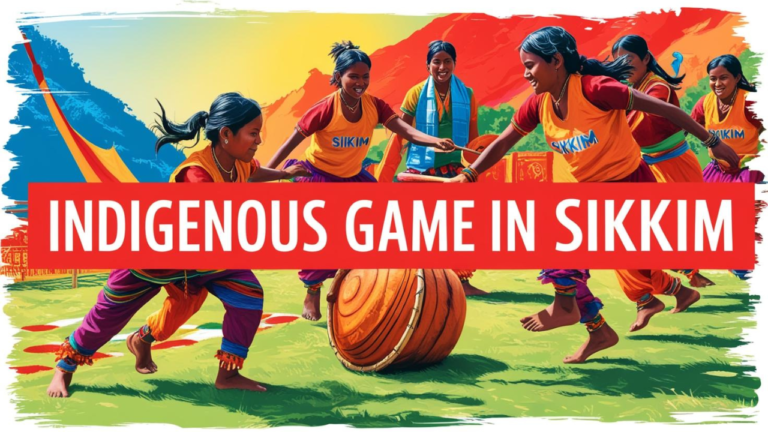Indigenous Game Yag Safari of Sikkim- Yag Safari is not a game but an excursion into the rich cultural past of Sikkim. The indigenous game is a blend of strategy, tradition, and adventure and thus

becomes part and parcel of the cultural heritage of the country.
Introduction– Indigenous Game Yag Safari of Sikkim
Sikkim, nestled deep in the Himalayas, is a nation of robust traditions and cultural orientation. One of its less popular treasures is the time-honored Sikkimese game of generations past—Yag Safari.
Not only does this time-honored Sikkimese game testify to the heterogeneity of Sikkimese people’s amusement activities but also their love for nature and culture.
When new gaming fashions dominate the amusement scene, classic games like Yag Safari offer a fascinating mix of tradition, strategy, and social interaction.
This blog discusses the background of Yag Safari, the legislation surrounding it, as well as its cultural significance, as well as the very considerable influence that Yag Safari has had on society.
A gaming enthusiast, a culture enthusiast, or simply interested in the strange traditional sports, this comprehensive treatment of
Yag Safari paints a picture of one of Sikkim’s most fascinating pursuits for you.
The History of Yag Safari: Background and Cultural Significance

Historical Background
The authentic game of Yag Safari finds its roots in Sikkimese customary traditions. The term ‘Yag’ is a traditional name in usage, describing ‘Yak’.
It illustrates the manner in which the game found shape in accordance with the nomadic and herding life in the area.
Yag Safari was a jovial yet challenging game for the yak herders who utilized to provide for Sikkim’s hilly pastures.
It evolved over the years into a formal game played at local festivities and community celebrations.
Cultural Significance
- Preservation of Heritage: Yag Safari is not just a game; it brings to mind the aboriginal way of life and the ancient knowledge passed from one generation to another.
- Social Bonding: The game enhances cooperation, planning, and amity among participants, hence generating social bonding among villages.
- Environmental Education: Since the game is all about trekking through nature, it develops a sense of sensitivity towards the preservation of the environment.

Rules and Steps to Play Yag Safari
Objective of the Game
Yag Safari is a strategy game in which the player needs to play the yak herder and travel through the mountainous area of Sikkim.
The primary objective of the game is to complete the safari route by fighting challenges and collecting essential resources for survival.
Equipment and Game Setup
- Number of players: 4–6 players.
- Board and Markers: Hand-painted boards with path marked on were employed in previous editions, whereas present versions employ digital editions or augmented reality (AR) modes.
- Dice or Spinners: Regulates pieces moving around the board.
- Challenge Cards: Mimics environmental and tactical obstacles, i.e., crossing rivers, stormy mountains, or wild attacks.
Step-by-Step Gameplay
Beginning the Journey
Players throw the dice to move along the game board, which defines different landscapes (mountains, rivers, valleys).
Gathering Resources
The players gather food, water, and shelter points for survival.
Confronted by Dilemmas
Challenge cards that are drawn may force the players to make strategic decisions, i.e., opting for shelter or diversion.
Trade and Strategic Planning
The players can trade resources that have been gathered by the other in order to optimize survival and progress.
Winning Safari
The winner is the one who covers the entire safari route using the correct materials and completes every challenge.
Positive Contributions of Yag Safari to Society
1. Educational Value
Yag Safari improves thought capacity, choice-making, and critical thinking. It introduces kids to environmentalism, geography, and local heritage.
2. Developing Cultural Identity
Younger generations become exposed to their ancestors’ lifestyle through Yag Safari and therefore are more set about their identity and culture-based pride.
3. Social and Outdoor Interaction
Whereas present video games, through the nature of the technology used, tend to enable solitary playing, Yag Safari enables cooperative interaction, narration, and communication.
4. Environmental Awareness
Because the game is a combination of nature preservation and resource management, it teaches players a higher level of sustainability.
5. Reintroduction of Old Games
With globalization affecting gaming trends, the reintroduction of classic games like Yag Safari preserves local culture and promotes diversity in the gaming industry.
Analysis: The Future of Yag Safari in a Digital World
With the evolution of digital gaming, the majority of the traditional games are on the verge of extinction. However, Yag Safari can evolve and survive in the modern era:
- Gamification and Digital Integration: With the incorporation of augmented reality (AR) and mobile apps, Yag Safari can reach new generations without compromising its cultural heritage.
- Tourism and Cultural Festivals: Marketing Yag Safari in the tour calendar and adventure festivals can increase cultural tourism in Sikkim.
- Educational Programs: Schools and institutions can add Yag Safari to their syllabus to teach students about local culture in an interactive way.
Conclusion
Yag Safari is not just an ancient game—it’s a cultural gem that embodies Sikkim’s sense of adventure.
Added to its rich historical foundation, learning opportunities, and potential online adaptation, Yag Safari can potentially leave a durable legacy among the people as well as the international gaming community.
Here are 5 brief and easy-to-read FAQs on the native game Yag Safari of Sikkim, every one with a distinct emphasis:
1. What is Yag Safari?
Yag Safari is a classic native game of Sikkim, based on the native lifestyle and with frequent strategic play replicating yak herding and survival in the wild.
2. Who plays Yag Safari?
The game is primarily played by rural youth and children of Sikkim, particularly during cultural events and social gatherings.
3. Why is Yag Safari culturally significant?
It shows the culture, values, and living style of the native people of Sikkim by maintaining local heritage through fun storytelling.
4. Is Yag Safari educationally valuable?
Yes, it enhances the strategic ability, cooperation, and awareness of local fauna and flora among the players.
5. In what ways does Yag Safari benefit the society?
It instills cultural pride, deepens community ties, and ensures the preservation of traditional knowledge for generations to come.

By adopting and diffusing such cultural games, we not only preserve our vibrant cultural heritage but also create worthy, engaging experiences for future generations.
If you are visiting Sikkim, do spare some time to experience Yag Safari.
Not only are you experiencing an adventure the old way, but you also get to be a part of an heritage that has tradition, strategy, and community fellowship highly valued.






